Telco 3.0: The Telco Cloud
Telco cloud exchange
But for some carriers, finding carrier-grade cloud services is more complicated than creating a fully virtualized telco from the ground up. Today’s public cloud market is not yet carrier-grade. That’s largely due to infrastructure-as-a-service (IaaS) solutions, like compute and storage, lack standardization. In order to inject standardization and transparency into the telco cloud, Zimory and Deutsche Boerse have created a carrier-grade cloud exchange that allows telcos to clearly compare services.
The Deutsche Boerse Cloud Exchange allows cloud service providers from around the world to offer standardized services in a turnkey environment. The marketplace is also based on industry standards and will enable buyers to compare and select the best offering for their needs and clearly enforceable though service level agreements (SLAs).
"Deutsche Boerse Cloud Exchange will fundamentally change how cloud computing resources are bought and sold," said Ruediger Baumann, former CEO of Zimory. "The time when contract negotiations took months will be over for most businesses. Standardizing IaaS offerings will revolutionize the cloud computing market in a similar way to how the GSM standard changed cellular telephony. Cloud services will be provided faster and in more varied ways. New cloud computing industries, application areas and brokerage services will develop. The necessary prerequisites for this new age of cloud computing are industry standards for IaaS and a neutral, secure marketplace, which we are creating together with Deutsche Boerse Group," he added.
Self-organizing networks (SON)
A virtualized cloud telco is also in a position to deploy self-organizing network functions. According to the 3rd Generation Partnership Project, or 3GPP, there are three distinct functions a network must meet to qualify as truly self organizing.
- Self configuration: This is important, because it simplifies and shortens the time it takes to launch and roll out new services.
- Self optimization: Automatic configuration of the network including coverage, capacity, handover and interference is an added benefit of a SON because it enables a network to adjust in real-time to the needs of the users.
- Self healing: Automatic correction of capacity problems and can account for slow moving changes in traffic, such as seasonal demand. For instance, the network will automatically know to prepare for bandwidth-heavy holidays, like Mother's Day, which is widely viewed as one of the busiest for networks in the U.S. and head off any potential failures or diminished service quality before it even happens.
These networks can, not only automatically and in real time, adjust to network demands, they can identify the specific content traversing the network and traffic it accordingly. This level of functionality is important for telcos offering services like premium video, which will rely on reliable delivery anytime. It also opens up the possibility of tiered data and content traffic carriage revenues.
"SON is an important enhancement that affords operators the benefit of increasing their overall network performance," Chris Pearson, President of 4G Americas said in an October news release. "With a scarcity of spectrum in the Americas, and in many countries worldwide, 3GPP continues to evolve the standards for network technology to serve customers' ever growing appetite for mobile broadband data," he continued.
Pearson added, "Although SON improves network performance and capacity issues, it is not a substitute for the wireless industry's important need for more spectrum to meet the challenge of the impending capacity crunch."
SON deployments are also accelerating as ever more LTE networks are being lit up. “Self-organizing networks offer an unbreakable network so you can build and design a network so it responds directly to what your end user is trying to do,” Twist says. “Programmable networks can test and roll out new services in moments.”
But what's most important to consider is that, although the technology is pretty straight forward, the telco implementation should be done in steps that make sense to each individual business and use case: that it's telco grade and can function in a multi-vendor environment.
Cloud computing, much like for personal and enterprise use is rapidly becoming a reality in the telco space. Although most networks, and their mobile elements, are still constrained by radio network limitations, the entire telecommunications enterprise behind that radio network is quickly evolving into a thinking, self-correcting cloud computing wonder. However, while the technology to launch telcos into the cloud is an imminent reality, the ultimate success will be determined by human business acumen and the prospects for a telecommunications organization to transform from an engineering-centric, hard-wired monolith, to an IT-based, lean, mean services-generating machine.



















